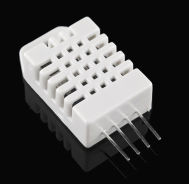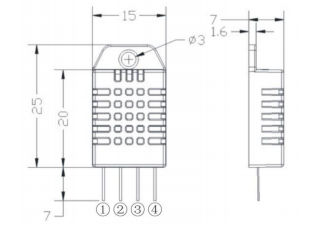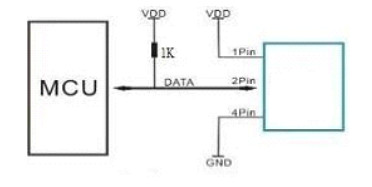In this chapter we make use of all of the ideas introduced in earlier chapters to create a raw interface with the low cost DHT11/22 temperature and humidity sensor. It is an exercise in implementing a custom protocol directly in C.
Now On Sale!
You can now buy a print or ebook edition of Raspberry Pi IoT in C from Amazon.
For Errata and Listings Visit: IO Press

This our ebook on using the Raspberry Pi to implement IoT devices using the C programming language. The full contents can be seen below. Notice this is a first draft and a work in progress.
Chapter List
-
Introducing Pi (paper book only)
-
Getting Started With NetBeans In this chapter we look at why C is a good language to work in when you are creating programs for the IoT and how to get started using NetBeans. Of course this is where Hello C World makes an appearance.
-
First Steps With The GPIO
The bcm2835C library is the easiest way to get in touch with the Pi's GPIO lines. In this chapter we take a look at the basic operations involved in using the GPIO lines with an emphasis on output. How fast can you change a GPIO line, how do you generate pulses of a given duration and how can you change multiple lines in sync with each other? -
GPIO The SYSFS Way
There is a Linux-based approach to working with GPIO lines and serial buses that is worth knowing about because it provides an alternative to using the bcm2835 library. Sometimes you need this because you are working in a language for which direct access to memory isn't available. It is also the only way to make interrupts available in a C program. -
Input and Interrupts
There is no doubt that input is more difficult than output. When you need to drive a line high or low you are in command of when it happens but input is in the hands of the outside world. If your program isn't ready to read the input or if it reads it at the wrong time then things just don't work. What is worse is that you have no idea what your program was doing relative to the event you are trying to capture - welcome to the world of input. -
Memory Mapped I/O
The bcm2835 library uses direct memory access to the GPIO and other peripherals. In this chapter we look at how this works. You don't need to know this but if you need to modify the library or access features that the library doesn't expose this is the way to go. -
Near Realtime Linux
You can write real time programs using standard Linux as long as you know how to control scheduling. In fact it turns out to be relatively easy and it enables the Raspberry Pi to do things you might not think it capable of. There are also some surprising differences between the one and quad core Pis that make you think again about real time Linux programming. -
PWM
One way around the problem of getting a fast response from a microcontroller is to move the problem away from the processor. In the case of the Pi's processor there are some builtin devices that can use GPIO lines to implement protocols without the CPU being involved. In this chapter we take a close look at pulse width modulation PWM including, sound, driving LEDs and servos. -
I2C Temperature Measurement
The I2C bus is one of the most useful ways of connecting moderately sophisticated sensors and peripherals to the any processor. The only problem is that it can seem like a nightmare confusion of hardware, low level interaction and high level software. There are few general introductions to the subject because at first sight every I2C device is different, but here we present one. -
A Custom Protocol - The DHT11/22
In this chapter we make use of all of the ideas introduced in earlier chapters to create a raw interface with the low cost DHT11/22 temperature and humidity sensor. It is an exercise in implementing a custom protocol directly in C. -
One Wire Bus Basics
The Raspberry Pi is fast enough to be used to directly interface to 1-Wire bus without the need for drivers. The advantages of programming our own 1-wire bus protocol is that it doesn't depend on the uncertainties of a Linux driver. -
iButtons
If you haven't discovered iButtons then you are going to find of lots of uses for them. At its simples an iButton is an electronic key providing a unique coce stored in its ROM which can be used to unlock or simply record the presence of a particular button. What is good news is that they are easy to interface to a Pi. -
The DS18B20
Using the software developed in previous chapters we show how to connect and use the very popular DS18B20 temperature sensor without the need for external drivers. -
The Multidrop 1-wire bus
Some times it it just easier from the point of view of hardware to connect a set of 1-wire devices to the same GPIO line but this makes the software more complex. Find out how to discover what devices are present on a multi-drop bus and how to select the one you want to work with. -
SPI Bus
The SPI bus can be something of a problem because it doesn't have a well defined standard that every device conforms to. Even so if you only want to work with one specific device it is usually easy to find a configuration that works - as long as you understand what the possibilities are. -
SPI MCP3008/4 AtoD (paper book only)
-
Serial (paper book only)
-
Getting On The Web - After All It Is The IoT (paper book only)
-
WiFi (paper book only)
The Device
The DHT22 is a more accurate version of the DHT11 and it is used in this project but the hardware and software will work with both versions and with the AM2302 which is similar to the DHT22.
Model AM2302/DHT22
Power supply 3.3-5.5V DC
Output signal digital signal via 1-wire bus
Sensing element Polymer humidity capacitor
Operating range
humidity 0-100%RH;
temperature -40~80Celsius
Accuracy
humidity +-2%RH(Max +-5%RH);
temperature +-0.5Celsius
Resolution or sensitivity
humidity 0.1%RH;
temperature 0.1Celsius
Repeatability
humidity +-1%RH;
temperature +-0.2Celsius

So the device will work at 3.3V and it makes use of a 1-wire open collector style bus which makes it very easy to make the physical connection to the Pi.
The one wire bus used isn't standard and is only used by this family of devices so we have little choice but to implement the protocol in C.

The pin outs are:
- VDD
- SDA serial data
- not used
- GND
and the standard way of connecting the device is:

Although the recommended pull up resistor is 1K a higher value works better with the Pi - typically 4.7K but larger will work.
The serial protocol is also fairly simple:
- The host pulls the line low for between 0.8 and 29 ms,
usually 1ms
- It then releases the bus which is pulled high
- After between 20 and 200 microseconds, usually 30 microseconds, the device starts to send data by pulling the line down for around 80 microseconds and then lets float high for another 80 microseconds.
- Next 40 bits of data are sent using a 70 microsecond high for a 1 and a 26 microsecond high for a zero the high pluses are separated by around 50 microsecond low period.

So what we have to do is pull the line low for 1ms or so to start the device sending data and this is very easy. Then we have to wait for the device to pull the line down and let it pull up again - about 160 microsecond and then read the time that the line is high 80 times.
A one corresponds to 70 microseconds and a zero corresponds to 26 microseconds.
This is within the range of pulse measurement that can be achieved using standard library function. There is also a 50 microsecond period between each data bit an this can be used to do some limited processing. Notice that we are only interested in the time that the line is held high.
When trying to work out how to decode a new protocol it often helps to try to answer the question - how can I tell the difference between a zero and a one. If you have a logic analyzer it can help to look at the wave form and see how you work it out manually. In this case for example, despite the complex looking timing diagram the difference comes down to a short verses a long pulse!
- Prev
- Next >>

